GOLDEN ORCHIDS STORE.
On this page, you find all documents, package deals, and flashcards offered by seller Emillect.
- 2872
- 0
- 65
Community
- Followers
- Following
2937 items
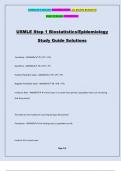
USMLE Bundled Exams Questions and Answers 100% Pass
USMLE Bundled Exams Questions and Answers 100% Pass
- Package deal
- • 6 items •
- USMLE Step 1 Biostatistics/Epidemiology Study Guide Solutions • Exam (elaborations)
- Public health science USMLE step 1 Exam Practice Questions and Answers • Exam (elaborations)
- USMLE STEP 1 Neurology Exam Practice Questions and Answers • Exam (elaborations)
- USMLE Step 1 Rapid Review Study Guide Solutions • Exam (elaborations)
- USMLE Step 1 Rapid Review Study Guide Solutions • Exam (elaborations)
- And more ….
USMLE Bundled Exams Questions and Answers 100% Pass
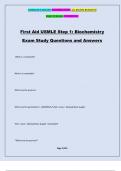
First Aid USMLE Step 1: Biochemistry Exam Study Questions and Answers
First Aid USMLE Step 1: Biochemistry Exam Study Questions and Answers What is a nucleoside? What is a nucleotide? Which are the purines? Which are the pyrimidines? - ANSWER-Side = base + (deoxy)ribose [sugar] Tide = base + (deoxy)ribose [sugar] + phosphaTe *Which are the purines?* ©EMILLECT 2024/2025 ACADEMIC YEAR. ALL RIGHTS RESERVED FIRST PUBLISH OCTOBER 2024 Page 2/152 "pure as gold" = Adenosine, Guanosine *Which are the pyrimidines?* "CUT the pyramid" = Cytosine, Ur...
- Exam (elaborations)
- • 152 pages •
First Aid USMLE Step 1: Biochemistry Exam Study Questions and Answers What is a nucleoside? What is a nucleotide? Which are the purines? Which are the pyrimidines? - ANSWER-Side = base + (deoxy)ribose [sugar] Tide = base + (deoxy)ribose [sugar] + phosphaTe *Which are the purines?* ©EMILLECT 2024/2025 ACADEMIC YEAR. ALL RIGHTS RESERVED FIRST PUBLISH OCTOBER 2024 Page 2/152 "pure as gold" = Adenosine, Guanosine *Which are the pyrimidines?* "CUT the pyramid" = Cytosine, Ur...
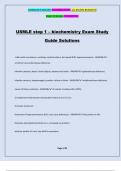
USMLE step 1 – biochemistry Exam Study Guide Solutions
USMLE step 1 – biochemistry Exam Study Guide Solutions infant with somnolence, vomiting, cerebral edema, decreased BUN, hyperammonemia - ANSWER- ornithine transcarbamoylase deficiency infantile cataracts, doesn't track objects, absent social smile - ANSWER-galactokinase deficiency infantile cataracts, hepatomegaly, jaundice, failure to thrive - ANSWER-uridyltransferase deficiency causes of Down syndrome - ANSWER-1) meiotic nondisjunction (95%) 2) unbalanced robertsonian translocation...
- Exam (elaborations)
- • 18 pages •
USMLE step 1 – biochemistry Exam Study Guide Solutions infant with somnolence, vomiting, cerebral edema, decreased BUN, hyperammonemia - ANSWER- ornithine transcarbamoylase deficiency infantile cataracts, doesn't track objects, absent social smile - ANSWER-galactokinase deficiency infantile cataracts, hepatomegaly, jaundice, failure to thrive - ANSWER-uridyltransferase deficiency causes of Down syndrome - ANSWER-1) meiotic nondisjunction (95%) 2) unbalanced robertsonian translocation...
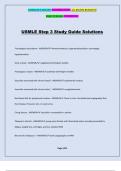
USMLE Step 3 Study Guide Solutions
USMLE Step 3 Study Guide Solutions Pseudogout associations - ANSWER-hemochromatosis, hyperparathyroidism, acromegaly, hypothyroidism Gout crystals - ANSWER-negatively birefringent needles Pseudogout crystals - ANSWER-positively birefringent needles Vasculitis associated with chronic Hep B - ANSWER-polyarteritis nodosa Vasculitis associated with chronic Hep C - ANSWER-cryoglobulinemia Best blood test for polyarteritis nodosa - ANSWER-There is none. Get abdominal angiography first, then bi...
- Exam (elaborations)
- • 63 pages •
USMLE Step 3 Study Guide Solutions Pseudogout associations - ANSWER-hemochromatosis, hyperparathyroidism, acromegaly, hypothyroidism Gout crystals - ANSWER-negatively birefringent needles Pseudogout crystals - ANSWER-positively birefringent needles Vasculitis associated with chronic Hep B - ANSWER-polyarteritis nodosa Vasculitis associated with chronic Hep C - ANSWER-cryoglobulinemia Best blood test for polyarteritis nodosa - ANSWER-There is none. Get abdominal angiography first, then bi...
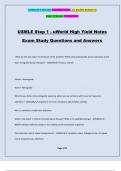
USMLE Step 1 - uWorld High Yield Notes Exam Study Questions and Answers
USMLE Step 1 - uWorld High Yield Notes Exam Study Questions and Answers What are the two major microtubular motor proteins? Which does anterograde axonal transport, which does retrograde axonal transport? - ANSWER-Kinesin, Dynein Kinesin: Anterograde Dynein: Retrograde` What do you think, immunologically speaking, when you see someone with recurrent Neisseria infections? - ANSWER-Inability to form the membrane attack (MAC) complex this is a common complement deficiency What is the defec...
- Exam (elaborations)
- • 74 pages •
USMLE Step 1 - uWorld High Yield Notes Exam Study Questions and Answers What are the two major microtubular motor proteins? Which does anterograde axonal transport, which does retrograde axonal transport? - ANSWER-Kinesin, Dynein Kinesin: Anterograde Dynein: Retrograde` What do you think, immunologically speaking, when you see someone with recurrent Neisseria infections? - ANSWER-Inability to form the membrane attack (MAC) complex this is a common complement deficiency What is the defec...
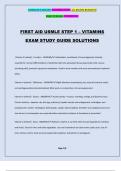
FIRST AID USMLE STEP 1 – VITAMINS EXAM STUDY GUIDE SOLUTIONS
FIRST AID USMLE STEP 1 – VITAMINS EXAM STUDY GUIDE SOLUTIONS Vitamin A (retinol) - Function - ANSWER-Antioxidant; constituent of visual pigments (retinal); essential for normal differentiation of epithelial cells into specialized tissue (pancreatic cells, mucus- secreting cells); prevents squamous metaplasia. Used to treat measles and acute promyelocytic leukemia (APL). Vitamin A (retinol) - Deficiency - ANSWER-Night blindness (nyctalopia); dry, scaly skin (xerosis cutis); corneal degen...
- Package deal
- Exam (elaborations)
- • 8 pages •
FIRST AID USMLE STEP 1 – VITAMINS EXAM STUDY GUIDE SOLUTIONS Vitamin A (retinol) - Function - ANSWER-Antioxidant; constituent of visual pigments (retinal); essential for normal differentiation of epithelial cells into specialized tissue (pancreatic cells, mucus- secreting cells); prevents squamous metaplasia. Used to treat measles and acute promyelocytic leukemia (APL). Vitamin A (retinol) - Deficiency - ANSWER-Night blindness (nyctalopia); dry, scaly skin (xerosis cutis); corneal degen...
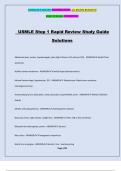
USMLE Step 1 Rapid Review Study Guide Solutions
USMLE Step 1 Rapid Review Study Guide Solutions Abdominal pain, ascites, hepatomegaly, (also high D dimer, CHF without JVD) - ANSWER-Budd-Chiari syndrome Achilles tendon xanthoma - ANSWER-Familial hypercholesterolemia Adrenal hemorrhage, hypotension, DIC - ANSWER-Waterhouse-Friderichsen syndrome (meningococcemia) Arachnodactyly, lens dislocation, aortic dissection, hyperflexible joints - ANSWER-Marfan's (fibrillin defect) Athlete with polycythemia - ANSWER-Erythropoietin injection B...
- Package deal
- Exam (elaborations)
- • 20 pages •
USMLE Step 1 Rapid Review Study Guide Solutions Abdominal pain, ascites, hepatomegaly, (also high D dimer, CHF without JVD) - ANSWER-Budd-Chiari syndrome Achilles tendon xanthoma - ANSWER-Familial hypercholesterolemia Adrenal hemorrhage, hypotension, DIC - ANSWER-Waterhouse-Friderichsen syndrome (meningococcemia) Arachnodactyly, lens dislocation, aortic dissection, hyperflexible joints - ANSWER-Marfan's (fibrillin defect) Athlete with polycythemia - ANSWER-Erythropoietin injection B...
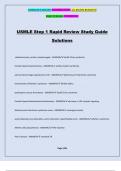
USMLE Step 1 Rapid Review Study Guide Solutions
USMLE Step 1 Rapid Review Study Guide Solutions abdominal pain, ascites, hepatomegaly - ANSWER-Budd-Chiari syndrome Familial hypercholesterolemia - ANSWER-achilles tendon xanthoma adrenal hemorrhage, hypotension, DIC - ANSWER-Waterhouse-Friderichsen syndrome biochemistry of Marfan's syndrome - ANSWER-fibrillin defect posthepatic venous thrombosis - ANSWER-Budd-Chiari syndrome Familial hypercholesterolemia biochemistry - ANSWER-decrease in LDL receptor signaling Waterhouse-Friderichsen...
- Package deal
- Exam (elaborations)
- • 66 pages •
USMLE Step 1 Rapid Review Study Guide Solutions abdominal pain, ascites, hepatomegaly - ANSWER-Budd-Chiari syndrome Familial hypercholesterolemia - ANSWER-achilles tendon xanthoma adrenal hemorrhage, hypotension, DIC - ANSWER-Waterhouse-Friderichsen syndrome biochemistry of Marfan's syndrome - ANSWER-fibrillin defect posthepatic venous thrombosis - ANSWER-Budd-Chiari syndrome Familial hypercholesterolemia biochemistry - ANSWER-decrease in LDL receptor signaling Waterhouse-Friderichsen...

USMLE STEP 1 Neurology Exam Practice Questions and Answers
USMLE STEP 1 Neurology Exam Practice Questions and Answers The notochord induces what to differentiate into what? - ANSWER-Induces overlying ECTODERM to differentiate into NEUROECTODERM and form NUERAL PLATE Neural plate then gives rise to? - ANSWER-Neural tube and neural crest cells Notochord becomes what? - ANSWER-Nucleus pulposus of the intervertebral disks in adults Alar Plate - ANSWER-Dorsal [Sensory] Same orientation as spinal cord Basal Plate - ANSWER-Ventral [Motor] Same orienta...
- Package deal
- Exam (elaborations)
- • 143 pages •
USMLE STEP 1 Neurology Exam Practice Questions and Answers The notochord induces what to differentiate into what? - ANSWER-Induces overlying ECTODERM to differentiate into NEUROECTODERM and form NUERAL PLATE Neural plate then gives rise to? - ANSWER-Neural tube and neural crest cells Notochord becomes what? - ANSWER-Nucleus pulposus of the intervertebral disks in adults Alar Plate - ANSWER-Dorsal [Sensory] Same orientation as spinal cord Basal Plate - ANSWER-Ventral [Motor] Same orienta...
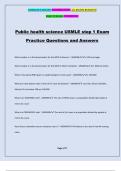
Public health science USMLE step 1 Exam Practice Questions and Answers
Public health science USMLE step 1 Exam Practice Questions and Answers What number is in the denominator for the RATE of divorce? - ANSWER-Per 100 marriages What number is in the denominator for the RATE of infant mortality? - ANSWER-Per 1000 live births What is the typical RATE given in epidemiology for most cases? - ANSWER-Per 100,000. What are most disease rates in the US for most all diseases? - ANSWER-Less than 50 per 100,000.... Almost ALL are below 100 per 100,000 What is an INCIDE...
- Package deal
- Exam (elaborations)
- • 71 pages •
Public health science USMLE step 1 Exam Practice Questions and Answers What number is in the denominator for the RATE of divorce? - ANSWER-Per 100 marriages What number is in the denominator for the RATE of infant mortality? - ANSWER-Per 1000 live births What is the typical RATE given in epidemiology for most cases? - ANSWER-Per 100,000. What are most disease rates in the US for most all diseases? - ANSWER-Less than 50 per 100,000.... Almost ALL are below 100 per 100,000 What is an INCIDE...
